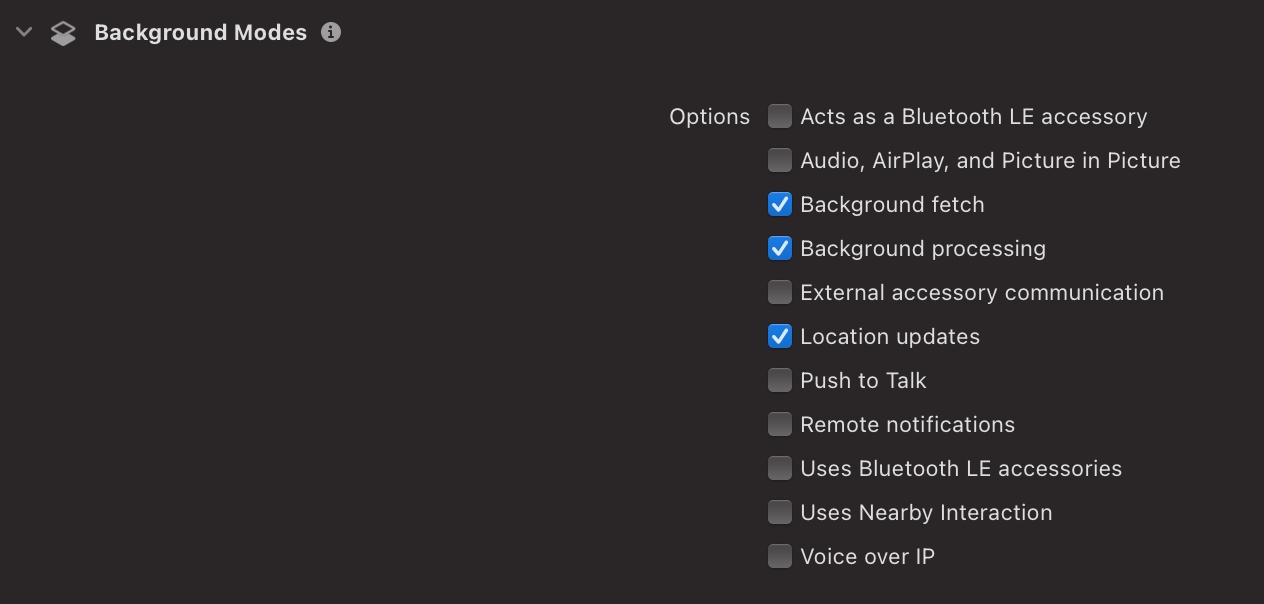Configuration
After adding the SDK, you must configure your project to ensure it is properly set up before you begin using the SDK. This configuration process includes setting up necessary permissions, modifying project settings, and making any additional changes required by the SDK to work correctly on both iOS and Android platforms.
iOS Configuration
Project Settings
Follow the instructions below to complete the necessary configuration steps.
Configuring Capabilities
Go to the Capabilities tab in your target settings.
Under Background Modes, enable the following:
Location updates
Background fetch
Background processing
Once configured the settings page should resemble the image below:

Setting Up Background Tasks
The GIZO SDK requires the specification of a background task identifier to handle background work. Follow these steps:
Go to Project settings and select your target.
Navigate to the Info tab.
Add Permitted background task scheduler identifiers if required.
Under this, add the sub-item:
de.artificient.backgroundtask.task_process
de.artificient.backgroundtask.task_refreshPermissions
Configure the required iOS permissions as specified in the table below:
LocationUsageDescription
LocationWhenInUseUsageDescription
LocationAlwaysUsageDescription
LocationAlwaysAndWhenInUseUsageDescription
MotionUsageDescription
Refer to the React Native permission acquisition guidelines for more information.
SDK License
Create a directory in the root of your project and add the license.json file to it. The file should follow the format shown below:
{
"license": "<license key>"
}Android Configuration
Permissions
Set up the required Android permissions as illustrated below:
ACCESS_FINE_LOCATION
ACCESS_COARSE_LOCATION
ACCESS_BACKGROUND_LOCATION
ACTIVITY_RECOGNITION
HIGH_SAMPLING_RATE_SENSORS
WRITE_EXTERNAL_STORAGE
READ_EXTERNAL_STORAGE
POST_NOTIFICATIONS
READ_PHONE_STATE
RECORD_AUDIO
The following items must also be configured:
AlarmScheduler
IgnoringBatteryOptimizations
UsageStats
The code snippet below must be added to Android Manifest file to specify the configurations, permissions, and metadata for an Android application.
?xml version="1.0" encoding="utf-8"?>
<manifest xmlns:android="http://schemas.android.com/apk/res/android"
xmlns:tools="http://schemas.android.com/tools">
<uses-permission android:name="android.permission.INTERNET"/>
<uses-permission android:name="android.permission.ACCESS_COARSE_LOCATION"/>
<uses-permission android:name="android.permission.ACCESS_FINE_LOCATION"/>
<uses-permission android:name="android.permission.ACCESS_NETWORK_STATE" />
<uses-permission android:name="android.permission.READ_EXTERNAL_STORAGE" />
<uses-permission android:name="android.permission.WRITE_EXTERNAL_STORAGE" />
<uses-permission android:name="android.permission.FOREGROUND_SERVICE" />
<uses-permission android:name="android.permission.POST_NOTIFICATIONS"/>
<uses-permission android:name="android.permission.ACTIVITY_RECOGNITION" />
<uses-permission android:name="android.permission.PACKAGE_USAGE_STATS" tools:ignore="ProtectedPermissions"/>
<uses-permission android:name="android.permission.WAKE_LOCK" />
<uses-permission android:name="android.permission.RECORD_AUDIO" />
<uses-permission android:name="android.permission.READ_PHONE_STATE" />
<uses-permission android:name="android.permission.REQUEST_IGNORE_BATTERY_OPTIMIZATIONS"/>
<uses-permission android:name="android.permission.ACCESS_BACKGROUND_LOCATION" />
<uses-permission android:name="android.permission.FOREGROUND_SERVICE_LOCATION" />
<uses-permission android:name="android.permission.HIGH_SAMPLING_RATE_SENSORS" />
<uses-permission android:name="android.permission.SCHEDULE_EXACT_ALARM"/>
<uses-permission android:name="android.permission.RECEIVE_BOOT_COMPLETED" />
<application
android:allowBackup="true"
android:dataExtractionRules="@xml/data_extraction_rules"
android:fullBackupContent="@xml/backup_rules"
android:icon="@mipmap/ic_launcher"
android:label="@string/app_name"
android:name=".Application"
android:roundIcon="@mipmap/ic_launcher_round"
android:supportsRtl="true"
android:theme="@style/Theme"
tools:targetApi="34" >
</application>
</manifest>SDK License
Navigate to the MainApplication.kt file in your Android project, locate the onCreate method, and add the GIZO SDK license as shown below:
override fun onCreate() {
super.onCreate()
SoLoader.init(this, false)
if (BuildConfig.IS_NEW_ARCHITECTURE_ENABLED) {
// If you opted-in for the New Architecture, we load the native entry point for this app.
load()
}
ApplicationLifecycleDispatcher.onApplicationCreate(this)
GizoSdkModule.initialize(context = this, license = "<license>")
}Last updated